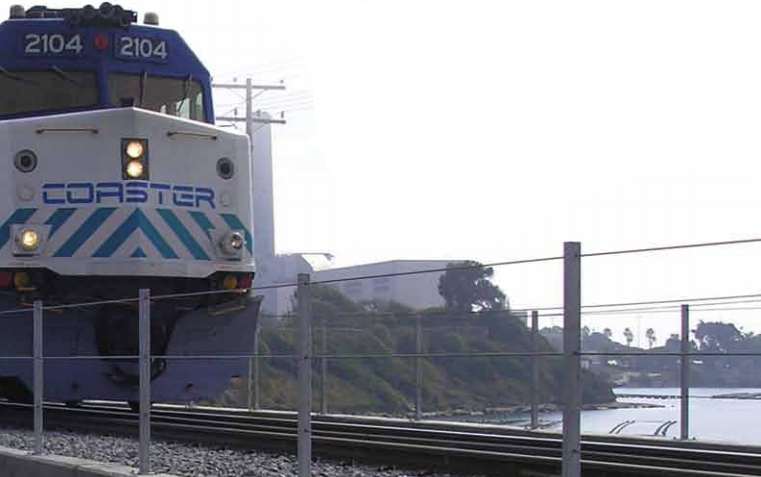Project News
Flatiron Has Executed More Than $1.5 billion in Rail Projects


Flatiron replaced a rail bridge over Agua Hedionda Lagoon in Carlsbad, Calif., along the COASTER commuter train route from Oceanside to San Diego.
For nearly 100 years, rail provided a large portion of the transportation in North America; however, trains quickly lost ridership when the first affordable cars came to market in the early 1900s. Since then, with the introduction of airplanes and the Interstate Highway System, passenger rail service has decreased significantly.
More recently, rail has made something of a comeback. Increasing fuel prices, rising concerns about greenhouse gas emissions, growing gridlock and strong support from the Obama administration are a few cited reasons for this resurgence. Although ridership has decreased nationally, there are certain places where rail currently remains a priority, like California.
According to the San Diego Association of Governments (SANDAG), which manages planning for one of three state-supported intercity rail corridors, California’s population grew 11 percent over the past 11 years. During that period, vehicle miles traveled grew only eight percent, while ridership on California’s three intercity passenger rail lines increased 43 percent.
Rail transit funding
Recent funding for rail transit has come from a combination of sources. In California, which has the nation’s second-largest rail transit network after the Northeast Corridor, voters approved a bond measure in 2008 for nearly $10 billion to build the core segments of a high-speed rail line between San Diego and San Francisco. The federal government, through the American Recovery and Reinvestment Act, has also committed funds for the project.
In Southern California, SANDAG recently adopted the 2050 Regional Transportation Plan, a 40-year, $214 billion blueprint for the San Diego region’s transportation future.
“The plan includes $17 billion to modernize and double-track existing rail and build 156 miles of new light rail line,” says Bill Prey, principal engineer and San Diego-Los Angeles-San Luis Obispo (LOSSAN) rail corridor director for SANDAG. Funding for this plan is also coming from a variety of sources. The federal government has provided a capital matching program that has resulted in $177 million in matching funds for corridor capital projects in California to date. Additionally, voter-approved tax increases and bond sales have provided a significant revenue source for the area’s rail transit. Measure R in Los Angeles was approved by two-thirds of voters and commits an estimated $40 billion for transportation, primarily for rail and rapid transit projects.
Flatiron’s rail strategy
With funding uncertainties at the federal level in the U.S., Flatiron Construction is focusing on California, where voter-approved tax increases provide a large portion of rail funding.
Flatiron is currently tracking projects for California’s first high-speed rail line and was recently shortlisted for a contract to construct the first 31-mile segment between Madera and Fresno. Other rail projects in the state include the Los Angeles Metro’s Crenshaw to Los Angeles International Airport line, Regional Connector, and Subway to Sea—nine miles of heavy rail with a 20-foot diameter tunnel.
In San Diego, SANDAG plans to construct a $1.7 billion extension of the San Diego Trolley from Old Town to the university area near La Jolla. And along the LOSSAN rail corridor, construction is ongoing to add a second mainline track to improve passenger and freight rail service.
Flatiron recently completed the replacement of the aging wooden trestle rail bridge at Trestles Beach, a popular surf spot in northern San Diego County. Additionally, Flatiron is working with SANDAG and the North County Transit District on other LOSSAN projects, including the $40 million replacement of the Santa Margarita bridge, the $39 million construction of 1.4 miles of second track in San Diego’s Sorrento Valley and the construction of the first of four planned pedestrian undercrossings in the City of Encinitas.
In Canada, Flatiron is focusing on both public and private rail projects. The primary focus is public sector rail, including projects in major metropolitan centers in British Columbia, Alberta and Ontario. Flatiron was one of three teams recently shortlisted to build the new 14-kilometer Evergreen Line in Vancouver, British Columbia.
“The funding for projects in Canada can be a complicated political negotiation process, as they normally require multigovernmental support,” says Steve Small, Flatiron’s vice president of business development. “And for the public-private partnership jobs, there is often the fare box revenue that the concessionaire must consider as part of the funding mechanism.”
Flatiron’s secondary focus is on building rail transit as mine infrastructure for private clients.
“There has been a surge in mining activity over the past few of years, and this is expected to grow significantly over the next decade,” Steve says. “With the infrastructure required to access these remote sites, Flatiron anticipates there will be further rail-related opportunities.”
What Flatiron Brings to Rail Projects
William Jensen, who heads Flatiron’s rail group in California, says that rail transit is a natural extension of Flatiron’s core business. “Rail projects are very similar to road or highway projects,” he says. “As the largest transportation contractor in the state, we bring the same expertise to a rail project. ”
Richard Grabinski, vice president and Benicia District manager, echoes William: “Rail projects require the same expertise as other large infrastructure, like project management, a labor force and strong relationships with partners and owners.”
Flatiron is also supported by sister companies like John Holland, which specializes in rail-specific services like testing, commissioning, maintenance and asset management and operations, as well as heavy-haul railway infrastructure for mines. “We also work closely with our parent company’s public-private partnership division, HOCHTIEF Solutions. Together, we offer clients financing, design, planning, construction and operation from a single source,” notes Steve.
Flatiron Construction has identified at least $25 billion in solid rail transit opportunities—mainly in California and Canada—over the next five years.
